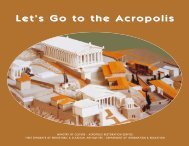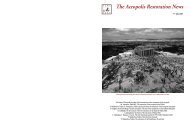τεύχος περιλήψεων - ΥΣΜΑ
τεύχος περιλήψεων - ΥΣΜΑ
τεύχος περιλήψεων - ΥΣΜΑ
Create successful ePaper yourself
Turn your PDF publications into a flip-book with our unique Google optimized e-Paper software.
6TH INTERNATIONAL MEETING FOR THE RESTORATION OF THE ACROPOLIS MONUMENTS - ABSTRACTS 15<br />
RESTORATION WORK ON THE ACROPOLIS 2000-2010<br />
M. Ioannidou, Civil engineer, NTUA. Director Emerita of the Acropolis Restoration Service (YSMA),<br />
Restoration Expert<br />
The beginning of the great restoration project on the Acropolis in 2000 coincided with the establishment<br />
of the Acropolis Restoration Service (YSMA) and the inclusion of restoration works<br />
in the Third Community Support Framework. The new Service launched new projects on the<br />
Acropolis monuments and accelerated their execution, following the principles and methodology<br />
established by the ESMA since 1975, while maintaining a close relationship with scientific research<br />
in all fields. In order to meet the requirements of the work, the Acropolis Restoration Service employed<br />
additional specialized scientific and technical personnel, according to strict selection criteria,<br />
and upgraded the equipment of the worksites with suitable lifting systems and special<br />
devices so as to facilitate the restoration work on the unique environment of the Acropolis.<br />
The primary goal of the interventions was the treatment of the serious structural damage suffered<br />
by the monuments, as well as the problems of surface erosion. However, research on the material<br />
that lay scattered on the rock as well as on that dismantled from the monuments, allowed<br />
the restoration of larger areas and the correction of missettings of the previous interventions.<br />
The restoration project for the years 2000-2010 involved the following interventions:<br />
• On the Parthenon: a) on the pronaos, intervention aiming at the restoration of the form of the<br />
inner colonnade of the east side of the monument following the identification of a significant<br />
number of scattered members belonging to it, b) on the opisthonaos, interventions which included<br />
the structural restoration of the architectural members of the entablature and the replacement<br />
of the original marble blocks of the frieze with copies of artificial stone, c) on the north<br />
side, where interventions included the structural restoration of architectural members and their<br />
restoration to their original positions on the monument.<br />
• On the Propylaia Central Building: a) on the north wall and on the east colonnade,<br />
b) restoration of extensive parts of the magnificent ceilings of the monument with architectural<br />
members that have been identified, through investigation.<br />
• Restoration of the Temple of Athena Nike<br />
The project also involves surface conservation works on all the monuments, consolidation and<br />
cleaning of the west frieze of the Parthenon, the recording and classification of the architectural<br />
members that lay scattered on the rock, documentation of the preservation condition of the<br />
Acropolis walls, the back-filling of the foundation of the House of Arrephoroi, as well as the great<br />
work of the geometric documentation and 3D scanning of the monuments, the Walls, and the<br />
Rock of the Acropolis. Other activities by the Acropolis Restoration Service also include the implementation<br />
of educational programmes in collaboration with the 1st Ephorate of Prehistoric<br />
and Classical Antiquities and the Acropolis Museum.<br />
Project funding from the Third Community Support Framework included € 32.6 million from<br />
the “Culture”programme and € 1.5 million from the“Information Society”programme. Additional<br />
funding of € 11 million has been provided by the Greek State.<br />
The special studies conducted before each intervention, the systematic documentation, the<br />
high quality of the works and the development of advanced technological applications during<br />
their execution are the main features of the works carried out in the period 2000-2010. Among<br />
their positive results must be included the training of highly specialized personnel in restoration<br />
interventions on classical monuments and the development of technical expertise to accelerate<br />
the performance of the work. These assets constitute an important contribution to the execution<br />
of other restoration interventions on the monuments of our country.








